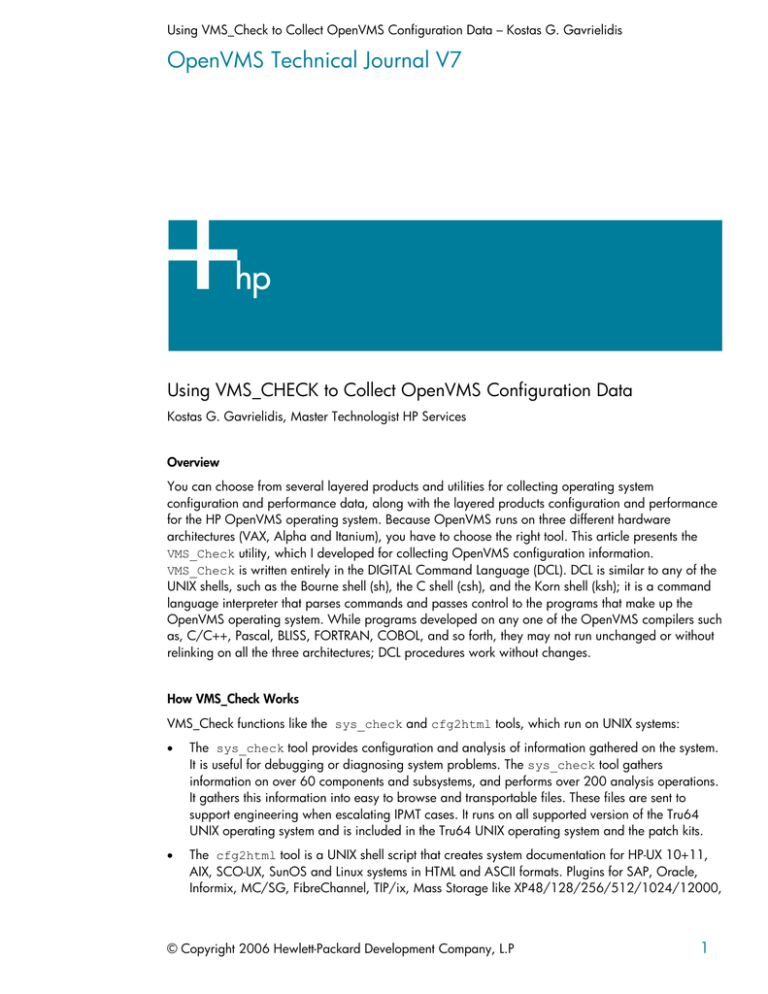Tool to collect OpenVMS configuration data - Tru64 UNIX
advertisement

Using VMS_Check to Collect OpenVMS Configuration Data – Kostas G. Gavrielidis
OpenVMS Technical Journal V7
Using VMS_CHECK to Collect OpenVMS Configuration Data
Kostas G. Gavrielidis, Master Technologist HP Services
Overview
You can choose from several layered products and utilities for collecting operating system
configuration and performance data, along with the layered products configuration and performance
for the HP OpenVMS operating system. Because OpenVMS runs on three different hardware
architectures (VAX, Alpha and Itanium), you have to choose the right tool. This article presents the
VMS_Check utility, which I developed for collecting OpenVMS configuration information.
VMS_Check is written entirely in the DIGITAL Command Language (DCL). DCL is similar to any of the
UNIX shells, such as the Bourne shell (sh), the C shell (csh), and the Korn shell (ksh); it is a command
language interpreter that parses commands and passes control to the programs that make up the
OpenVMS operating system. While programs developed on any one of the OpenVMS compilers such
as, C/C++, Pascal, BLISS, FORTRAN, COBOL, and so forth, they may not run unchanged or without
relinking on all the three architectures; DCL procedures work without changes.
How VMS_Check Works
VMS_Check functions like the sys_check and cfg2html tools, which run on UNIX systems:
•
The sys_check tool provides configuration and analysis of information gathered on the system.
It is useful for debugging or diagnosing system problems. The sys_check tool gathers
information on over 60 components and subsystems, and performs over 200 analysis operations.
It gathers this information into easy to browse and transportable files. These files are sent to
support engineering when escalating IPMT cases. It runs on all supported version of the Tru64
UNIX operating system and is included in the Tru64 UNIX operating system and the patch kits.
•
The cfg2html tool is a UNIX shell script that creates system documentation for HP-UX 10+11,
AIX, SCO-UX, SunOS and Linux systems in HTML and ASCII formats. Plugins for SAP, Oracle,
Informix, MC/SG, FibreChannel, TIP/ix, Mass Storage like XP48/128/256/512/1024/12000,
© Copyright 2006 Hewlett-Packard Development Company, L.P
1
Using VMS_Check to Collect OpenVMS Configuration Data – Kostas G. Gavrielidis
EVA3000/EVA5000, Network Node Manager, and OmniBack/DataProtector, and so forth, are
included.
VMS_Check is a DCL procedure that runs on all the three OpenVMS architectures and is extendable -you can include in it any series of OpenVMS commands as if you were entering them at the
OpenVMS operating system command prompt (the $). The current version of the VMS_Check tool
collects data from any system, standalone or in an OpenVMS Cluster, and presents it in both its
original form and with HTML wrappers. The main report is an HTML file named of VMS_Check<nodename>-<ddmonyy-hhmm>.HTML. For example:
VMS_Check-OWL-14MAR2005-1516.HTML
This main file is supported by several text and HTML files, which contain the actual data that make up
the complete system report.
The Purpose of VMS_Check
The primary goal in devoloping the VMS_Check tool was to collect the data on a customer’s
configuration. It started out as a small procedure with the goal to collect database related
configuration information. Slowly it grew to a large DCL command procedure that now includes
operating system and storage configuration information.
All of the VMS_Check report sections include information in tables or plain text which can easily be
used elsewhere, such as in any of the Microsoft tools Word, Excel, etc.
Table 1 shows an example of a table generated on an OpenVMS Cluster system, including
information about each node, its version, node name, current date and time, and system uptime.
BBCX Cluster Nodes Table
OpenVMS Version Node Name
Current Date and Time
Uptime
OpenVMS V7.3-2
BBC200
25-FEB-2005 11:40:47.70
27 10:33:44
OpenVMS V7.3-2
BBC202
25-FEB-2005 11:40:47.73
27 09:51:18
OpenVMS V7.3-2
BBC204
25-FEB-2005 11:40:47.78
9 12:45:43
...
...
...
...
OpenVMS V7.3-2
BBC309
25-FEB-2005 11:40:48.12
19 12:44:58
OpenVMS V7.3-2
BBC311
25-FEB-2005 11:40:48.15
2 12:05:09
Table 1 Cluster Nodes Table
Data Collected by VMS_Check
The VMS_Check tool collects setup and configuration information for databases and associated
layered products, such as Oracle, Rdb, ACMS, Ingres, and so forth, on OpenVMS platforms.
© Copyright 2006 Hewlett-Packard Development Company, L.P
2
Using VMS_Check to Collect OpenVMS Configuration Data – Kostas G. Gavrielidis
Figure 1- VMS_Check Report in the MS IE Browser
Sections of VMS_Check Reports
As in most generated HTML reports, VMS_Check creates a table of contents at the beginning of the
report. The following example shows the table of contents generated by the VMS_Check tool:
© Copyright 2006 Hewlett-Packard Development Company, L.P
3
Using VMS_Check to Collect OpenVMS Configuration Data – Kostas G. Gavrielidis
Table of Contents
OpenVMS Operating System
Console: Variables| RAD Information| Partition Information
Procedures for System: Sylogin| Startup| Shutdown| ModParams
System identification information: GETSYI of this node| GETSYI of all VMScluster nodes|
Show commands for: System| CPU| Memory| Pool | Files| Reserved Memory| RMS| Users| Logicals|
Symbolics|
Analyze: System| RAD| SpinLock|
Errolog and Crash Information: Errorlog| DECevent| Crash analysis
SYSGEN Parameters: SYSGEN| Startup| Special| All
System Access and Control: UAF Records| User Rights| Proxies| SYSTEM UAF record| DEFAULT UAF records|
Table
Installed Images: Installed images
System tests: RADcheck
VMScluster Configuration Information: VMScluster| Noders Table| GETSYI table for all VMScluster nodes
Storage Subsystem Configurations
Storage: Devices| IO Bus| IO Circuits| IO Devices| Mounted| Devices Table| Devices Charts| Devices
Fragmented Files| Stripe| RAID| FDDI| HSC| HSJ
Network and Related Products Information
Network| NCP | NCL | LATCP | LANCP | UCX | MultiNet
Database Information/Configurations
SQL: SQL| SQL Images| UAF Records
Relational Database Operator: RDO
Oracle Rdb: Images| Logicals| Versions| Databases| Schemas| Statistics| UAF Records
Oracle RDBMS: Oracle| Schemas| Statistics| UAF Records
Sybase RDBMS: Sybase| UAF Records
Ingres RDBMS: Ingres| UAF Records
Transaction processing and other layered product information
ACMS: ACMS| Images
TDMS: TDMS
DECforms: DECforms
PathWorks: PathWorks
DECWindows: DECwindows
DECthreads: Images
CMA: Images
Layered Products: Installed| Installation History| Licensed
HyperSort: Images
Performance Data
Performance Solution Advisor (PSA)| Monitor Utility
Tables
VMScluster nodes| GETSYI information for all VMScluster nodes| Devices| SYSUAF
Interactive Sessions
0:Mornitor| 1:Rdb| 2:Rdb| 3:ACMS| 4:PSA| 5:SPL
Goto: Top|Contents|Bottom
© Copyright 2006 Hewlett-Packard Development Company, L.P
4
Using VMS_Check to Collect OpenVMS Configuration Data – Kostas G. Gavrielidis
Navigating the VMS_Check Report
You can jump to different sections of interest in the report from inside the main HTML report file, and
under each section of the report. The following menu appears:
Goto: Top | Contents | Bottom
Section: System |Storage |Network | Database |Layered Products | Performance | Interactive
The Goto references jump to the Top, Table of Contents and Bottom sections of the report.
The Section references jump to the System, Storage, Network, Database, Layered Products,
Performance and Interactive sections of the report.
Internal References to Other Files
The main VMS_Check report file contains internal references to other text and HTML files generated
by VMS_Check. These file references are described in Table 2. This example was generated for the
OpenVMS system named OWL.
Internal References generated for OWL
Reference
Description
Devices_Mounted-OWL.txt
All devices mounted
Devices_DU-OWL.txt
All DU devices
Devices_HSJ-OWL.txt
All HSJ devices
SDA-of-running-OWL.txt
Analyze System
SPL-of-running-OWL.txt
Spinlock Information
...
...
PSA-Brief-OWL.TXT
Performance Analysis (Brief)
PSA-Full-OWL.TXT
Performance Analysis (Full)
PSA-Perf-OWL.TXT
Performance Evaluation
MON-ALL-SUM-OWL.TXT
Monitor all classes (Summary)
MON-ALL-AVE-OWL.TXT
Monitor all classes (Average)
Table 2 - Internal References
Information about Mounted Devices
Table 3 shows the table of all mounted devices that is generated by VMS_Check in the Storage
section of the report. It include information about each device, including the device name, the volume
name, the device type, the total blocks, the free blocks, percent of blocks free, fragmentation index,
and the fragmentation report.
© Copyright 2006 Hewlett-Packard Development Company, L.P
5
Using VMS_Check to Collect OpenVMS Configuration Data – Kostas G. Gavrielidis
Devices on OWL
Device
Volume
Type
Total blocks Free blocks %Free Frag Index Frag Report
_DSA2:
ALP_SITEB
DGX00
68251131
24772725
36
44.1
frpt
_DSA11:
ALPHA_USER
DGX00
71112778
24899409
35
5.2
frpt
_DSA12:
DATABASE
DGX00
213291762
38709535
18
2.4
frpt
_DSA500:
OWL_PAGE
DKX00
35565080
20564320
57
30.2
frpt
Table 3 - Mounted Devices Table
VMS_Check generates a bar graph for the percent of free disk space and the fragmentation index for
all devices. Figure 2 shows the pie chart graph of the total disk capacity, which includes the total
MB’s used and free disk space.
Figure 2 - Mounted Devices Charts
Console Environment Variables
Table 4 describes some of the information that can be collected from the console.
© Copyright 2006 Hewlett-Packard Development Company, L.P
6
Using VMS_Check to Collect OpenVMS Configuration Data – Kostas G. Gavrielidis
Console Variables for OWL
Name
V/N
Value
Function
RESTART
Specifies the action the console will take
following an error, halt or power-up.
Values are: restart, boot and halt
auto_fault_restart
UNDEFINED
Controls whether the SCM will restart
when a fault is encountered.
Boot_dev
N
SCSI3 0 10 0 3 0 0 0 @wwid0,SCSI3 0
10 0 4 0 0 0 @wwid0,SCSI3 0 8 0 1 0 0
0 @wwid0,SCSI3 0 8 0 2 0 0 0 @wwid0
Defines the default device or device list
from which booting is attempted when
no device name is specified by the boot
command.
N
SCSI3 0 10 0 3 0 0 0 @wwid0,SCSI3 0
10 0 4 0 0 0 @wwid0,SCSI3 0 8 0 1 0 0
0 @wwid0,SCSI3 0 8 0 2 0 0 0 @wwid0
Defines the default device or device list
from which booting is attempted when
no device name is specified by the boot
command.
...
...
auto_action
N
Bootdef_dev
...
Table 4 - Console Environment Variables
GETSYI Information
The GETSYI informatoin for a single node is shown in Table 5.
GETSYI Information for EMPIRE
Type
Value
Description
ACTIVECPU_CNT
2
Count of the CPUs actively participating in the current boot of the
symmetric multiprocessing (SMP) system.
AVAILCPU_CNT
2
Number of CPUs available in the current boot of the SMP system.
ARCHFLAG
245760
Architecture flags for the system
ARCH_NAME
Alpha
Name of the CPU architecture on which the process is executing
BOOTTIME
24-SEP-2004
14:11:24.00
The time when the node was booted.
VP_MASK
0
Longword mask, the bits of which, when set, indicate which
processors in the system have vector coprocessors.
VP_NUMBER
0
Unsigned longword containing the number of vector processors in
the system.
…
Table 5 - GETSYI Information From a Single Node
© Copyright 2006 Hewlett-Packard Development Company, L.P
7
Using VMS_Check to Collect OpenVMS Configuration Data – Kostas G. Gavrielidis
GETSYI clusterwide information is shown in Table 6
GETSYI Information for all VMSCluster Nodes
Item
EMPIRE Value
AIRTRN Value
…
STORM Value
CLUSTER_EVOTES
11
11
11
CLUSTER_FSYSID
0000000034AD
0000000034AD
0000000034AD
CLUSTER_MEMBER
TRUE
TRUE
TRUE
CLUSTER_NODES
11
11
11
DECNET_FULLNAME
LOCAL:.EMPIRE::
LOCAL:.AIRTRN::
LOCAL:.STORM::
HW_MODEL
1976
1962
2030
HW_NAME
AlphaServer ES45
Model 2
AlphaServer DS10L
617 MHz
hp AlphaServer ES47
7/1000
NODENAME
EMPIRE
AIRTRN
STORM
...
...
...
NODE_SYSTEMID
0000000035A5
0000000034B0
00000000343A
NODE_VOTES
1
0
1
...
...
Table 6 - Clusterwide GETSYI Information
How to Use VMS_Check
You can invoke the VMS_Check tool with the VMS_Check-detail.COM command procedure,
which is included with the software kit. This command procedure invokes the VMS_Check command
procedure by setting the appropriate privileges and flags for VMS_Check to collect configuration
information about the RDBMSs and the OpenVMS environment. For example:
$ @VMS_Check-Detail
This DCL command procedure actually performs the following steps:
$! Determine output file name
$!
$ nodename = f$getsyi("nodename")
$ systime = f$edit(''f$time()', "TRIM")
$ date = f$element(0, " ", systime)
$ time = f$element(1, " ", systime)
$ day = f$element(0, "-", date)
$ mon = f$element(1, "-", date)
$ year = f$element(2, "-", date)
$ hour = f$element(0, ":", time)
$ min = f$element(1, ":", time)
$ if f$length(day) .eq. 1 then day = "0"+day
$ filename = "VMS_Check-"+nodename+"-"+day+mon+year+""+hour+min+".HTML"
$! show symbol filename
$ SET PROC/PRIV=(ALL,NOBYPASS)
$ exec := SPAWN/NOWAIT/INPUT=NL:/OUTPUT='filename'
© Copyright 2006 Hewlett-Packard Development Company, L.P
8
Using VMS_Check to Collect OpenVMS Configuration Data – Kostas G. Gavrielidis
$! show symbol exec
$ EXEC @VMS_Check.COM HTML DETAIL
To invoke VMS_Check in a single system environment, enter the following commands:
$ SET PROC/PRIV=(ALL,NOBYPASS)
$ EXEC:= SPAWN/NOWAIT/INPUT=NL: /PROCESS=VMS_Check /OUTPUT=VMS_Check-'F$getsyi("NODENAME")'.HTML
To generate HTML output and to get a DETAIL description of the current environment, enter the
following command:
$ EXEC @VMS_Check.COM HTML DETAIL
To debug VMS_Check, enter the following command:
$ EXEC @VMS_Check.COM DEBUG NODETAIL
The DEBUG option creates the VMS_Check.DEBUG file in the current directory. This file has a
record of all actions performed by VMS_Check preceded by a time stamp for the start of each action.
To generate HTML output from all the nodes on the VMS Cluster, enter the following commands:
$ MCR SYSMAN
SYSMAN> SET ENV/CLUSTER
SYSMAN> DO _SYSMAN> SPAWN
_SYSMAN> /INPUT=NL:/OUTPUT=VMS_Check_'F$getsyi("NODENAME")'.HTML _SYSMAN> /PROCESS=VMS_Check _SYSMAN> @DSA110:[KOSTAS.DEV]VMS_Check.COM HTML NODETAIL
SYSMAN> EXIT
Completing the Report Generation
The completion state of the report is at the end of the generated HTML file. Figure 3 shows an
example of successful report generation:
*---------------------------------------------------------------------*
*
*
VMS_Check has successfully completed.
*
*
*---------------------------------------------------------------------*
Generated by VMS_Check.COM X0.1-177 on 16-MAY-2005 14:13:31.10
Figure 3 - Successful Report Generation
How to Review the VMS_Check Report
To review the report and associated generated files, transfer them from the OpenVMS environment to
another environment, such as a Windows laptop, Use FTP to transfer all the files generated by
VMS_Check, in ASCII mode. For example, you can use the following FTP commands to transfer the
VMS_Check files to your laptop for review:
ftp> open a.b.c.d.com
Connected to a.b.c.d.com.
220 a.b.c.d.com FTP Server (Version 5.4) Ready.
User (a.b.c.d.com:(none)): kostas
331 Username kostas requires a Password
© Copyright 2006 Hewlett-Packard Development Company, L.P
9
Using VMS_Check to Collect OpenVMS Configuration Data – Kostas G. Gavrielidis
Password:
230 User logged in.
ftp> cd [kostas.dev.prey]
250-CWD command successful.
250 New default directory is DSA11:[KOSTAS.DEV.PREY]
ftp> hash
Hash mark printing On
ftp: (2048 bytes/hash mark) .
ftp> prompt
Interactive mode Off .
ftp> mget *
...
ftp> quit
For more information
For informaton about cfg2html, go to http://come.to/cfg2html.
For information about sys_check, go to: http://h30097.www3.hp.com/sys_check/
To get a copy of the VMS_CHECK tool please download:
http://h71000.www7.hp.com/openvms/journal/v7/vms_check.zip
© Copyright 2006 Hewlett-Packard Development Company, L.P
10





